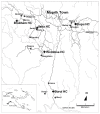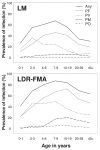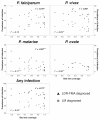High sensitivity detection of Plasmodium species reveals positive correlations between infections of different species, shifts in age distribution and reduced local variation in Papua New Guinea
- PMID: 19284594
- PMCID: PMC2657150
- DOI: 10.1186/1475-2875-8-41
High sensitivity detection of Plasmodium species reveals positive correlations between infections of different species, shifts in age distribution and reduced local variation in Papua New Guinea
Abstract
Background: When diagnosed by standard light microscopy (LM), malaria prevalence can vary significantly between sites, even at local scale, and mixed species infections are consistently less common than expect in areas co-endemic for Plasmodium falciparum, Plasmodium vivax and Plasmodium malariae. The development of a high-throughput molecular species diagnostic assay now enables routine PCR-based surveillance of malaria infections in large field and intervention studies, and improves resolution of species distribution within and between communities.
Methods: This study reports differences in the prevalence of infections with all four human malarial species and of mixed infections as diagnosed by LM and post-PCR ligase detection reaction-fluorescent microsphere (LDR-FMA) assay in 15 villages in the central Sepik area of Papua New Guinea.
Results: Significantly higher rates of infection by P. falciparum, P. vivax, P. malariae and Plasmodium ovale were observed in LDR-FMA compared to LM diagnosis (p < 0.001). Increases were particularly pronounced for P. malariae (3.9% vs 13.4%) and P. ovale (0.0% vs 4.8%). In contrast to LM diagnosis, which suggested a significant deficit of mixed species infections, a significant excess of mixed infections over expectation was detected by LDR-FMA (p < 0.001). Age of peak prevalence shifted to older age groups in LDR-FMA diagnosed infections for P. falciparum (LM: 7-9 yrs 47.5%, LDR-FMA: 10-19 yrs 74.2%) and P. vivax (LM: 4-6 yrs 24.2%, LDR-FMA: 7-9 yrs 50.9%) but not P. malariae infections (10-19 yrs, LM: 7.7% LDR-FMA: 21.6%). Significant geographical variation in prevalence was found for all species (except for LM-diagnosed P. falciparum), with the extent of this variation greater in LDR-FMA than LM diagnosed infections (overall, 84.4% vs. 37.6%). Insecticide-treated bednet (ITN) coverage was also the dominant factor linked to geographical differences in Plasmodium species infection prevalence explaining between 60.6% - 74.5% of this variation for LDR-FMA and 81.8% - 90.0% for LM (except P. falciparum), respectively.
Conclusion: The present study demonstrates that application of molecular diagnosis reveals patterns of malaria risk that are significantly different from those obtained by standard LM. Results provide insight relevant to design of malaria control and eradication strategies.
Figures



References
-
- Haworth J. The global distribution of malaria and the present control effort. In: Wernsdorfer WH, McGregor IA, editor. Malaria – Principle and Practice of Malariology. Vol. 2. Edinburgh: Churchill Livingstone; 1988. pp. 1379–1420.
Publication types
MeSH terms
Substances
Grants and funding
LinkOut - more resources
Full Text Sources
Other Literature Sources
Medical

